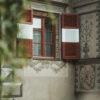The THALLO Boutique Hotel complex in Zhangzhou, China, is not only impressive because of its exterior, which was modelled on a ship. The project is an impressive example of how architecture is integrated into mountainous surroundings in China.
A huge, immovable, almost impenetrable mass of earth. This is probably the general definition of what we usually call a ‘mountain’ in our latitudes. Not so in Far Eastern culture. They do not see mountains as something rigid, motionless, but as something flowing, constantly in motion, constantly changing. Just like clouds or even air.

For BUZZ (Büro Ziyu Zhuang) Architects, with offices in Beijing, Shanghai and Berlin, this image is a recurring theme in their work. The studio regularly focuses on embedding its concepts in the natural surroundings of the locations, especially in mountainous landscapes – as is the case with the design of the THALLO Boutique Hotel.
In the flow
BUZZ Architects designed a prime example of how architecture is integrated into mountains in China on 4,000 square metres in the heart of the Mayang River region near Zhangzhou in the south-eastern Chinese province of Fujian. The result is a building complex ‘that harmonises with the terrain and reflects the natural contours of the landscape with its flowing form’, as the architecture firm emphasises.
The idea behind the design becomes clear at first glance at the project: a ship navigating through the waves. With its numerous ‘decks’, the THALLO Boutique Hotel virtually breaks out of the (wave) mountain towards the Mayang Valley. The design is characterised by its clear lines; it also creates numerous terraces and inner courtyards from which guests can get a wide variety of impressions of the building and its surroundings.


The undulating roof and viewing platforms offer additional views of the river and the surrounding mountains. Roof overhangs and curved bridges between the individual levels minimise the impression of volume and lend the hotel’s stable concrete structure an unexpected lightness.
Exploration is required
The interplay between architecture and nature also manifests itself in the interior design. The rooms in the hotel are designed to fit seamlessly into the topography of the mountain. And merge with it, as it were. And here, too, the focus is on flow. According to BUZZ Architects, the architecture creates a continuous flow inside the building that draws people in and invites them to explore.

While the exterior of the hotel complex is kept in different shades of grey, its interior is bright and friendly. A deliberate visual conflict that gives the architecture both softness and strength, say the architects. Numerous lounges offer guests the opportunity to sit down and enjoy the view from floor-to-ceiling windows, work or socialise. ‘The design offers a modern reinterpretation of traditional scroll reading, where architecture and nature together tell a story of beauty and tranquillity,’ explains BUZZ.
The art of reading
The hotel also has its own bookshop, which invites guests to retreat to read – panoramic views included. The Hotel is also connected to a new cultural and creative quarter, where cultural activities and events will take place in the future. For the architects, this is proof of how architecture can have a lasting positive impact on its surroundings and redefine its natural environment.


‘The innovative design of THALLO Boutique Hotel not only respects the natural landscape, but enhances it,’ says BUZZ Architects. ‘It creates a unique destination that offers tranquil moments surrounded by nature. As a cultural and creative centre, it sets new standards for architectural excellence.’
Text: Michi Reichelt
Bilder: Schran Image, Heguang Image









